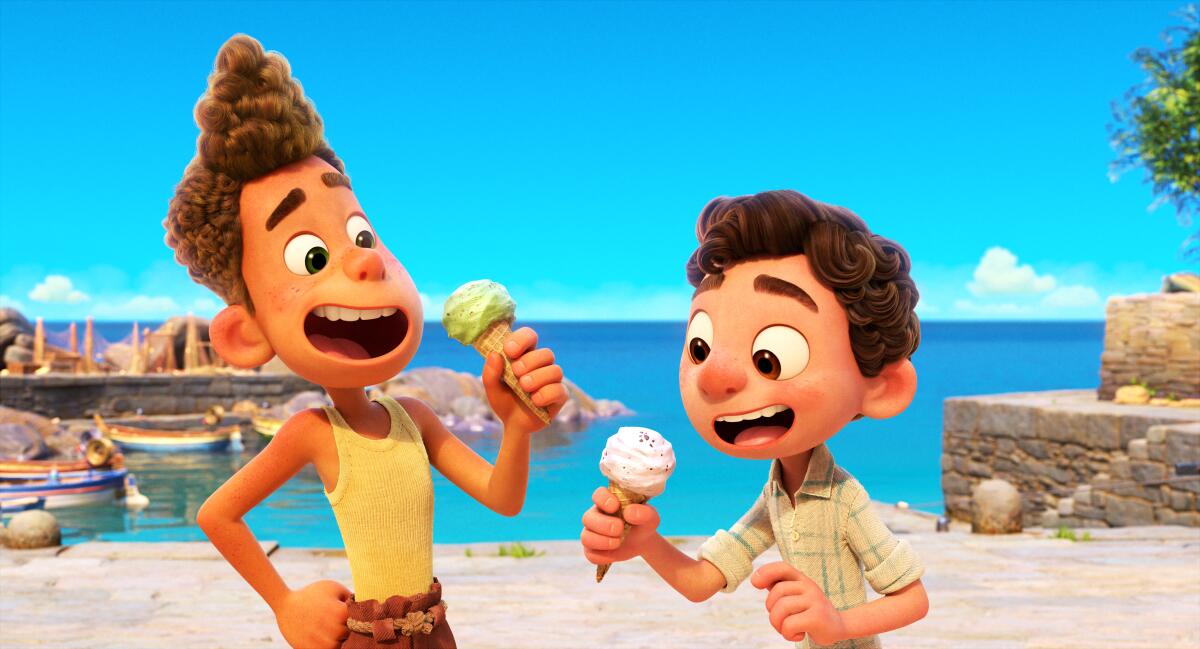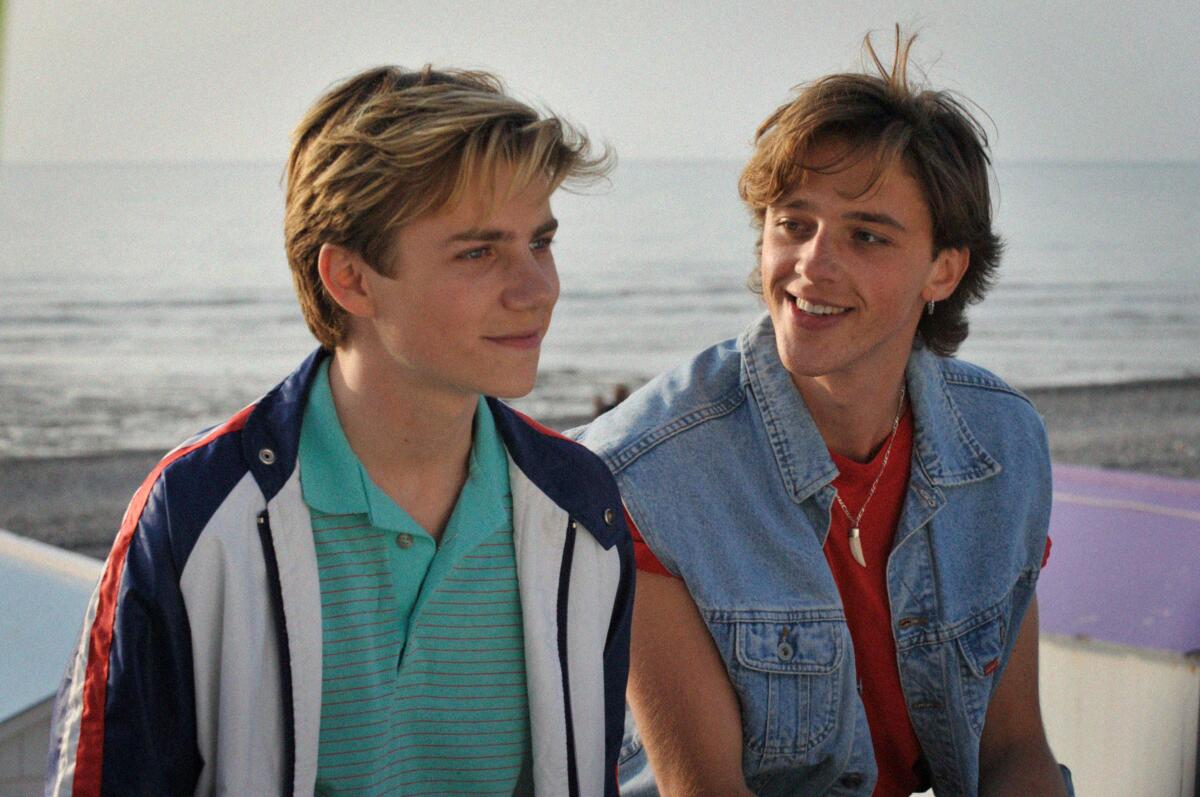Indie Focus: An oddball musical odyssey in ‘The Sparks Brothers’
Hello! I’m Mark Olsen. Welcome to another edition of your regular field guide to a world of Only Good Movies.
Only good movies
Get the Indie Focus newsletter, Mark Olsen's weekly guide to the world of cinema.
You may occasionally receive promotional content from the Los Angeles Times.
Last weekend, The Times published a powerful series of stories that explore the Latino culture gap in Hollywood. There were honestly too many great stories to summarize them all here. The entire package is worth the time to read through, but here are a few highlights:
Daniel Hernandez surveyed the breadth of the problem, as Latinos will soon make up 20% of the U.S. population, but less than 5% of Hollywood speaking roles go to Latino actors.
This timeline explains the history of Latino representation in Hollywood.
Yvonne Villarreal had a behind-the-scenes look at the recent series “Selena” and how it was underfunded, creating undue production pressures; the piece also covers qualitative aspects of how Hollywood perpetuates the problem of Latino representation onscreen, in writers rooms, executive suites and beyond.
The series was in part timed to coincide with the release of “In The Heights,” and the film has continued to generate conversation. Ryan Faughnder examined why it underperformed at the box office, while Ashley Lee took a look at whether the very practice of box office projections hurts films like “In The Heights.”
Fidel Martinez dug into the controversy over the film’s lack of Afro-Latinx casting, which gained wider attention when Rita Moreno attempted to defend the movie and Lin-Manuel Miranda and then apologized for what she said. Justin Chang reviewed the new documentary “Rita Moreno: Just a Girl Who Decided to Go for It,” which opens today.
This week on “The Envelope” podcast, I spoke with John Boyega about his role in “Red, White and Blue,” one part of the “Small Axe” anthology on Amazon Prime, as well as the intense year he had both personally and professionally, which found him speaking out at a protest rally in London while filming a role as a whistleblower police officer.
“I just think that it’s strange the way sometimes reality and art can spark these kind of conversations,” said Boyega. “So the relationship between those two things, I just think that’s what naturally happens with life sometimes. It just added up and lined up in a way that we could have never tracked.
“So for me, it’s still strange that kind of happened around the same time,” he said. “Definitely it wasn’t me. I didn’t control that s—. But that’s just how it went down.”
Enjoying this newsletter? Consider subscribing to the Los Angeles Times
Your support helps us deliver the news that matters most. Become a subscriber.
‘The Sparks Brothers’
Edgar Wright directs his first documentary with “The Sparks Brothers,” a loving portrait of brothers Ron and Russell Mael, better known as the band Sparks. For more than 50 years, they have created iconoclastic pop music that has given them just enough success to keep going. The film is in general release.
For The Times, Glenn Whipp wrote, “If you care about Sparks, this movie is heaven, a long-overdue answer to the group’s 1994 song ‘When Do I Get to Sing “My Way.“’ (With this doc, Ron and Russell have to feel, at least a little bit, ‘like Sinatra felt.’) If you don’t know about Sparks, Wright has created an introduction that gleefully demolishes any barrier you might think you have toward their music. And if you think you don’t care about Sparks, do know that later this year, there’s a movie called ‘Annette,’ featuring an original story, music and songs by the band. It stars Adam Driver and Marion Cotillard and will open the Cannes Film Festival next month. So, yeah, not a bad time to get up to speed on Sparks.”
Also for The Times, Gary Goldstein spoke to the Mael brothers about the experience of having a film made about them. As Ron said, “We’ve resisted having a documentary made about us for so long because we felt that that kind of compression … would not be the kind of true look at what the band was — and is. But knowing what kind of filmmaker Edgar is, plus he stressed that he wanted to have each of our musical periods [represented] … If we were ever going to do it, he was the right person. We have no complaints.”
Russell added, “When we set out to do this, we said, ‘Please, we hope this will be an Edgar Wright film, that it will look like an Edgar Wright film and that this won’t be the outlier — the dull, boring, dry documentary.”
For the New York Times, Glenn Kenny wrote, “They’re a cult band with an ever-renewing cult and a career that spans 50 years. ‘The Sparks Brothers,’ an energetic documentary directed by Edgar Wright, explains their appeal in part by emphasizing how it cannot be explained. … Wright, the virtuoso director of ‘Shaun of the Dead’ and ‘Baby Driver,’ among others, and an ace soundtrack assembler, is uniquely suited to make this tribute. Both director and band revel in formal play. Their eccentricity doesn’t entirely shut out earnestness.”
For Time, Stephanie Zacharek wrote, “Sparks — a code name for real-life brothers Ron and Russell Mael — are often described as an art-pop duo, which is as good a description as any, given that they’ve influenced bands across roughly five decades without becoming conventional superstars themselves. And they will probably continue to inspire and confound until the end of time — Sparks are that inexplicable, and that durable. … There’s a lot of material here — ‘The Sparks Brothers’ runs a whopping two hours and 15 minutes, though it feels as fleet as a three-minute pop song. OK, maybe a four-minute pop song — but this grand, big-little film leaves you wanting more of Sparks, not less. If you’ve only sort-of heard of Sparks, ‘The Sparks Brothers’ is a great place to begin. If you’re already a fan, you’ll go nuts for it. And if you’re like me, you’ll never lose track of Sparks again.”
For Variety, Jessica Kiang wrote, “Even if they never conquer Hollywood or attain Beyoncé-level fame, there’ll always be that crazily eclectic, melancholy and vibrant catalogue of music — not just the two dozen albums they’ve already recorded, but the dozens more that Ron, now 75, and Russell, 72, agree they probably still have in them, ‘given the advances in medical science.’ May they live forever.”

‘Luca’
Directed by Enrico Casarosa, “Luca” is the latest animated release from Pixar. Luca (voiced by Jacob Tremblay) is a young sea creature living off the coast of Italy. He heads to land disguised as a human boy along with his new friend Alberto (Jack Dylan Grazer) and the two have adventures among the human world while careful to disguise their true selves. The film is playing locally at the El Capitan and is streaming on Disney+.
For The Times, Justin Chang wrote, “‘Luca’ is about the thrill and the difficulty of living transparently — and the consolations that friendship, kindness and decency can provide against the forces of ignorance and violence. Liberating oneself from those forces is a matter of individual and collective responsibility, and ‘Luca’ is nuanced enough to understand that everyone shoulders that responsibility differently. … What makes Luca this story’s namesake hero is that he’s able to absorb the best of what his friends and family pour into him; though small and lean (and sometimes blue and green), he stands at the point where their best instincts and deepest desires converge. By the same token, ‘Luca’ the movie may look slight or modest compared with its more extravagant Pixar forebears; certainly it lacks the grand metaphysical ambitions of the Oscar-winning ‘Soul’ (whose director, Pete Docter, is an executive producer here). But that may explain why it ultimately feels like the defter, more surefooted film, and one whose subtle depths and lingering emotions belie the diminished platform to which it’s essentially been relegated. ‘Luca’ is big in all the ways that count; it’s the screens that got small.”
Tracy Brown spoke to Casarosa, who discussed the story’s inspiration by saying, “I thought, ‘Oh, what an interesting possibility here in conveying some secret that we have and this oddness that we feel as kids.’ During those difficult years of finding yourself, you do feel ‘Whose body is this?’ even.”
For the New York Times, A.O. Scott wrote, “Unlike some other recent Pixar features, this one aims to be charming rather than mind-blowing. Instead of philosophical and cinematic ambition, there is a diverting, somewhat familiar story about friendship, loyalty and competition set against a picturesque animated backdrop. So not a masterpiece, in other words. But also not a pandering, obnoxious bit of throwaway family entertainment. … It’s about the sometimes risky discovery of pleasure, and it’s a pleasure to discover.”
For Vulture, Alison Willmore wrote, “Luca is so intent on meaning something that it only ever halfway inhabits the delightfully colorful world it lays out. … The film would rather evoke [Luca] Guadagnino and Hayao Miyazaki, especially the latter’s ‘Porco Rosso’; the 1992 movie is an obvious touch point. But ‘Luca’ doesn’t have the lived-in texture of a Studio Ghibli production, either, that palpable sense of a universe extending beyond each animated frame. What it does have are some groovy Italian pop songs and a setting as pleasant as a summer afternoon. The light glimmers off the surface of the ocean without any worry of going too deep.”
For Cartoon Brew, Carlos Aguilar wrote, “What makes ‘Luca’ so deeply special is that, aside from cultural nods to Casarosa’s native Italy galore (visual and linguistic), the story zooms in on the bonds that boys can form before the yoke of traditional masculinity is imposed on them. Their sincere love for one another overlooks societal expectations. Through the deceivingly effortless playfulness of the story, [co-writers Jesse] Andrews and [Mike] Jones show how betrayals at such an age feel catastrophic, how Luca seeks validation in Alberto, and in turn how that creates a follower-leader dynamic between them at first. … Just like Luca and Alberto are one thing on land and another when submerged, Casarosa’s ‘Luca’ is at once a bright ray of sunshine and a deep dive into fraternal connection.”

‘Summer of 85’
Written and directed by François Ozon, based on the novel “Dance on My Grave” by Aidan Chambers, “Summer of 85” is as it sounds, a re-creation of that specific time set amid the French seaside. Alexis (Félix Lefebvre) meets David (Benjamin Voisin) and the two strike up an intense romantic relationship. Valeria Bruni Tedeschi and Melvil Poupaud have supporting roles. The film is playing at a number of Laemmle locations.
For The Times, Justin Chang wrote, “In ‘Summer of 85,’ [Ozon] attempts to bridge a gap that spans several decades, to revisit his youthful impressions of the material from an older, ostensibly wiser perspective. He also conjures something that feels like ’80s nostalgia — whose fashions, hairstyles and music are always a reliable source of cinematic pleasure — without abandoning the present tense. … As Ozon has noted in interviews, this particular journey has taken its own strange metafictional turns, given how much ‘Dance on My Grave’ seems to anticipate key themes and plot devices from the director’s other movies. ‘Summer of 85’ has the matter-of-fact sensuality and youthful focus of so many of Ozon’s earlier films, but it’s also a startlingly specific greatest-hits compilation from across the director’s tirelessly productive career. “
For the New York Times, Beatrice Loayza wrote, “[U]nlike many recent L.G.B.T.Q. romances that deploy retrograde views on homosexuality as a convenient tool for conflict, ‘Summer of 85’ uses its vibrant throwback aesthetic to situate two gay men in a cultural fantasy typically reserved for straight couples: the date at the carnival that ends in a fistfight with an embittered ‘ex,’ the star-crossed lovers who sneak around and make morbid, lifelong pacts. Toward the end of the film, reflecting on his time with David, Alexis realizes how he has become a character in a fantastic story — a story full of intrigue and drama, yes, but also one that is light and joyous. Too few queer characters, who are often saddled with tragedy, are so capable of moving on.”
For The Wrap, Alonso Duralde wrote, “‘Summer of ’85’ gets its 1985-ness right, from bookending the action with The Cure’s ‘In Between Days’ to the jeans and the typewriters. And nobody since Eric Rohmer gets the joys and the agony of young love under the French summer sun as well as Ozon does, time and again. … For as prolific a filmmaker as Ozon continues to be, his occasional misses are far outweighed by his offbeat and insightful forays, particularly in the realm of sexuality — exploring both the best parts and the crazy-making parts. For audiences equally interested in his insights about loss and about love, there’s plenty to ponder in ‘Summer of ’85.’”

Only good movies
Get the Indie Focus newsletter, Mark Olsen's weekly guide to the world of cinema.
You may occasionally receive promotional content from the Los Angeles Times.




